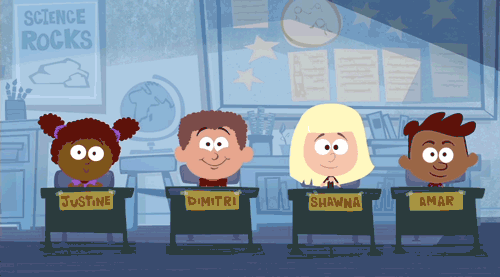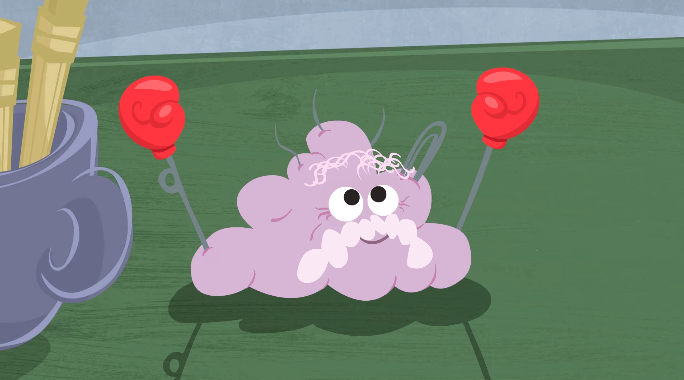Every collaboration has an origin story. “Just as in science, ‘a-ha!’ moments don’t really come out of nowhere,” Jean Flanagan of the Smithsonian Science Education Center (SSEC) explains. But after hard work, a lot of research, and a dash of creativity, an “a-ha!” moment did happen – and that moment turned into Good Thinking! The Science of Teaching Science, SSEC’s new, animated professional development series for science educators.
Jean is a Science Education Research Specialist on SSEC's curriculum and communications team, and was a key player in developing the series. “We had an incredibly diverse and talented team who put a lot of hard work into the central challenge: conveying research findings through breezy, humorous exchanges between animated characters,” Jean says. She credits much of the success of the project to the FableVision/SSEC team’s willingness to adapt to different communication strategies, as we worked to create a ground-breaking professional development resource.
FableVision chatted with her about Good Thinking!’s origin story, the ideas that started it all, and the animated character she most relates to.
Can you share a bit about how the FableVision Studios/SSEC partnership formed?
It all started with a bid from FableVision that had two awesome concepts: “It Came From the Fridge” and “Public Science Announcement.” In the first, we see a rotten fruit from the teacher’s lounge fridge saying, “so, I heard you had some questions about photosynthesis?” In the second, an omniscient narrator presides, 1950s PSA style, over a colorful classroom in retro-style animation. We immediately took to these ideas as awesome ways to get the teacher into dialogues that wouldn’t otherwise happen in a classroom populated only by teacher and students. Fans of the series can probably easily see how these concepts evolved into our (less rotten) talking classroom objects and our (dumber) narrator. A kickoff meeting and many hilarious conference calls later, we were a team!
Original Good Thinking! concept art by Renee Kurilla.
Original Good Thinking! concept art by Pete Paquette.
What were the steps in creating Good Thinking?
It might be easier to list some steps that weren’t part of the process! Here’s an egregiously abbreviated version:
- Search the science education literature for topics that are well-studied and have actionable advice for teachers.
- For each topic, develop a template that lists the overall goal of the video, key misconceptions, correct ideas, where the misconceptions come from, and how this knowledge should impact a teacher’s instruction.
- Work with multiple content and entertainment writers to write, edit, and revise three drafts of each script. Each script was reviewed by a subject matter expert, often someone who was involved in the research highlighted in the script.
- Work with voice actors to record the scripts.
- Create an animatic (moving storyboard) of each episode. Visuals were reviewed by subject matter experts again, as well as the whole SSEC team.
- Produce a rough cut (full animation, but no lip sync or sound design), which is then reviewed by the SSEC team.
- Produce a final cut (edits incorporated, lip sync, sound and music added). This is reviewed again by SSEC and then a Master is created.
What was one of the biggest challenges of creating Good Thinking?
The subject matter we wanted to convey has never really gotten a lot of play in popular media. While “science explainers” are popular on YouTube and general education tips aren’t that hard to find, very few non-academic resources exist that tackle the subtleties of the interface of science content, student thinking, and pedagogy. This meant that we didn’t have any examples to work from. Even many of our science writers and subject matter experts were initially confused by the specific goals of the project. This challenge forced us to test and refine our communication strategies multiple times before finalizing each script, ultimately strengthening the project.
What was it like to balance the research/science and the creative in developing the series? What was a stand out “a-ha!” moment during the series development?
Well, just as in science, “a-ha!” moments don’t really come out of nowhere in any project. While we originally considered having the teacher be off-screen, one of our best decisions was to put Ms. Isabella Reyes front and center — her intelligence, quirkiness, and drive to learn and improve perfectly embody the incredible respect we have for the teaching profession, and teachers have told us they find her very relatable.



Can you share a bit about the students? They have such different personalities, why not make them all uniform?
It was important to us to convey the idea that science is for all students, regardless of personality or background. And from the teacher’s perspective, the more diversity of ideas, background knowledge, and approaches students come in with, the richer every activity and class discussion will be. Plus, we wanted an excuse to throw in some skateboarding and breakdancing.
What classroom character do you relate to and why?
In 5th grade, I guess I was a Dimitri-Shawna hybrid. I could definitely be a bit of a know-it-all in science class, but for the most part I was pretty spacey and prone to daydreaming and bad poetry. Now I’m more of a Gummerson — a bit disgruntled (working in education will do that) but ever optimistic!
What is in Ms. Reyes’s future?
I hope a nice, long vacation somewhere beautiful and exotic that’s not Amar’s brain. Then we’d like to put her to work doing more videos.
Jean Flanagan is a Science Education Research Specialist on the SSEC's curriculum and communications team. At SSEC she works to translate research and policy into practice, informing the development of standards-aligned curriculum and professional development resources. Most recently she served as a project lead in the development of a new web series on “the science of teaching science”: Good Thinking! Prior to joining SSEC, Flanagan worked as a Research Associate at AAAS Project 2061. While there she worked closely with key national standards documents—including the Benchmarks, NSES, the NRC's Framework, and early drafts of the NGSS—and contributed to multiple federally-funded research and development projects focused on best practices in standards-aligned science curriculum and assessment. Through this work she spent a significant amount of time working closely with teachers and students in classrooms around the country to field test assessments and curriculum materials.
Don’t miss a single episode! Watch the series on SSEC’s YouTube channel.



